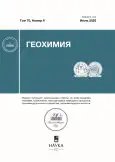Vol 70, No 6 (2025)
Articles
NEON AS A CRITERION FOR NOBLE GAS DISTRIBUTION BETWEEN GAS ACCUMULATIONS AND EDGEWATER
Abstract
 427-457
427-457


CARBON BEHAVIOR AND FORMATION OF WATER CHEMICAL COMPOSITION IN THE DRAINAGE SYSTEM OF THE DRAINED EUTROPHIC PEATLAND
Abstract
 458-479
458-479


DISTINCTIVE FEATURES OF SEDIMENTATION IN THE TALAYA GROUP OF GLACIAL LAKES, KOLYMA HIGHLANDS, DURING THE LATE NEOPLEISTOCENE–HOLOCENE: GEOCHEMICAL EVIDENCE
Abstract
A group of Talaya lakes (Gryazevoe, Schuch’e, Goluboe, Nalimnoe are located in the east of the Maimandzhinsky Mountains (Kolyma Highlands). The lakes are of glacial origin. They were formed during the Late Neopleistocene-Early Holocene. Geochemical characteristics of lake sediments, tephra, deluvial deposits, and bedrock were obtained. Based on the analysis of the distribution of major elements, SiO2/TiO2, Fe2O3/TiO2, Fe2O3/MnO, SiO2/Al2О3, SiO2/MgO, SiO2/Fe2O3 ratios, ICV, CIA indices, and principal component analysis data, geochemical zones reflecting various sedimentation conditions have been established in sediments. The intervals of biogenic, terrigenous and chemogenic (autigenic) accumulation were revealed. Autigenic iron–containing minerals are represented by sulfides (pyrite, pyrrhotite). Clastic minerals are titanomagnetites, magnetites, and ilmenites. The dependence of the ratios of elements and indices on the graine size of granulometric fractions of deluvium has been studied, the relationship between the geochemical characteristics of lake sediments and deluvial deposits has been established. The main stages of lake development have been reconstructed. A comprehensive characterization of the sediments of the transition interval from the Late Neopleistocene to the Holocene was obtained.
 480-502
480-502











